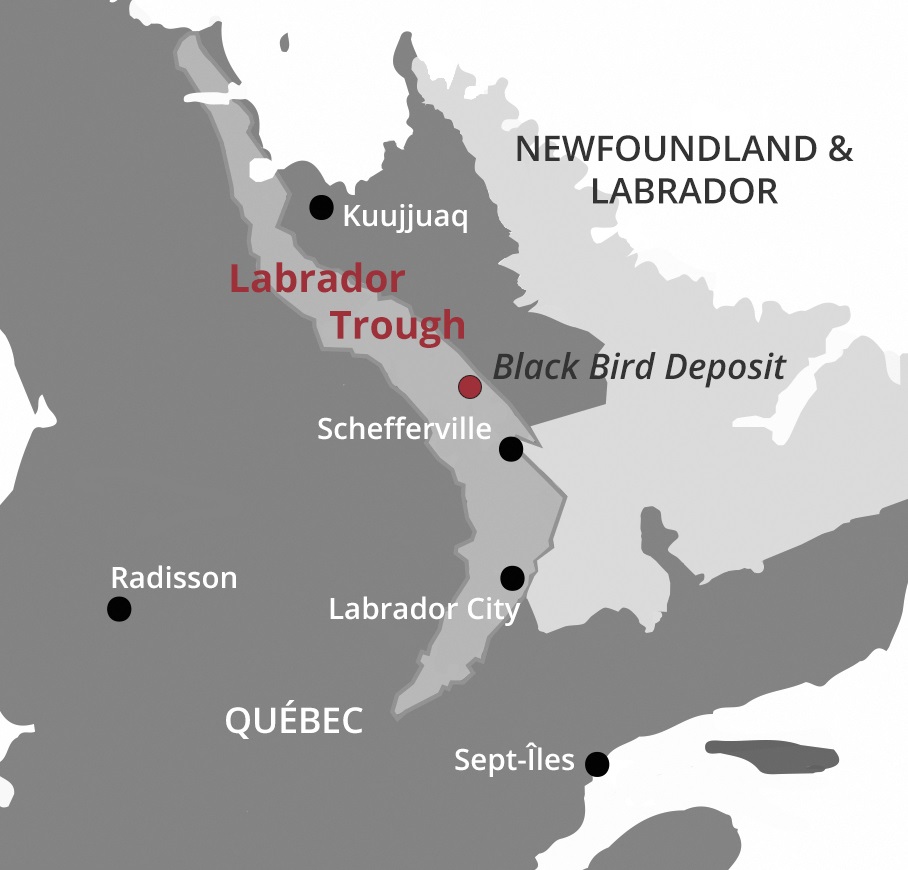
The Black Bird Direct Shipping Ore (“DSO”) Deposit is part of the Sunny Lake property. In March 2015, Century announced a mineral resource estimate for the Black Bird DSO Deposit.
Project Summary
| Project Facts |  |
|
| Location | ~65km NW of Schefferville | |
| Mineral | Iron Ore DSO | |
| Indicated | 1.55 million tonnes at 59.93% TFe | |
| Inferred | 8.61 million tonnes at 57.01% TFe | |
Mineral Resource Statement
| Mineral Resource Statement (as of Feb 27, 2015)1 | ||||||
| Resource Classification | Quantity (tonnes) | % TFe | % SiO2 | % Al2O3 | % Mn2 | % P2 |
| Total Indicated | 1,550,000 | 59.93 | 7.23 | 0.87 | 1.68 | 0.04 |
| Total Inferred | 8,607,000 | 57.01 | 12.60 | 1.07 | 1.13 | 0.05 |
|
||||||
Technical Report
April 14, 2015
Location, Access and Infrastructure
The Black Bird DSO Deposit is located 65 kilometres northwest of the town of Schefferville, Québec. The property is only accessible by helicopter or float plane from Schefferville. A seasonally maintained gravel road ends at Lac du Drum about 20 kilometres from the Black Bird DSO Deposit.
The Black Bird DSO Deposit is located within the Sunny Lake Property that includes 102 map-designated claims located in Quebec, covering an area of approximately 5018.02 hectares (February 2021). The mineral rights exclude surface rights and were acquired by map staking. All claims are located on Crown Lands.
The town of Schefferville is the nearest town with established infrastructure.
Background Geology
Aeromagnetic data clearly show that within the footprint of the Black Bird and the Full Moon properties, the magnetic units are characterized by kilometric, tight to open, non-cylindrical structures interpreted as anticline and syncline, with thickened hinges and attenuated limbs.
Such patterns are indicative of favourable settings for concentration of iron mineralization post emplacement with potential to develop more economic concentrations.
The Black Bird DSO Deposit is considered to host first-priority targets owing to past historical work that indicate six iron showings (Tremblay, 1952). Five returned assay values exceeding 55% iron, indicating potential for DSO iron mineralisation. According to this historical work, these DSO targets occupy topographically recessive areas (valleys) coinciding with magnetic lows located in synformal fold structures.
The Middle Iron Formation unit (including the Pink Grey Chert) was also identified on the Black Bird DSO Deposit, indicating that this property is a prospect for taconite-type iron mineralization.
Geological Interpretation and Modelling
The DSO mineralization was defined using logging information (Hard and Soft DSO), at a cut-off grade of 50 percent iron, based on a break in the statistical distribution of assay data. The geological interpretation was conducted on vertical section perpendicular to the interpreted strike of the open fold using the Gemcom GEMS software package. The DSO mineralization boundaries (Hard and Soft) were drawn as rings and joined across sections by tie lines to form wireframes, honouring the interpreted stratabound geometry of the mineralization. The DSO zones were extended outwards 50 metres across-strike and 100 metres along-strike and halfway between boreholes. An overburden surface was modelled by SRK using Leapfrog and used to constrain the start of near-surface mineralization. SRK assigned rock codes to each lithology, domain, and waste type.
Mineral Resource Estimate
The database available for geology and mineral resource modelling comprises borehole information acquired in 2011 and 2014. This database contains information from 34 core boreholes (3393.1 metres) and 2 reverse circulation boreholes (198.0 metres). The subset of borehole data considered for mineral resource modelling comprises 13 core boreholes (1,301.6 metres) for which complete assay results are available. The boreholes are distributed on section lines spaced at 50 to 250 metres and borehole spacing along each section line of 50 to 100 metres. The assay database comprises 101 sample intervals from 13 boreholes assayed for the common major oxide elements.
Mineral Resource Statement
The optimization parameters include reasonable mining, processing, handling and shipping costs (average of US$60 per dry metric tonne of mineralization); long term prices for lump and fines direct shipping products benchmarked against other projects (averaging US$96 per dry metric tonne); penalties for deleterious elements; premiums for iron grade; and an exchange rate of US$ to CDN$ of 0.80.
Using these assumptions, essentially the entire modelled DSO mineralization is contained within the conceptual pit shell. After a review, SRK considers that it is appropriate to report as a mineral resource those classified blocks located within the conceptual pit shell, and above a cut-off grade of 50 percent total iron.